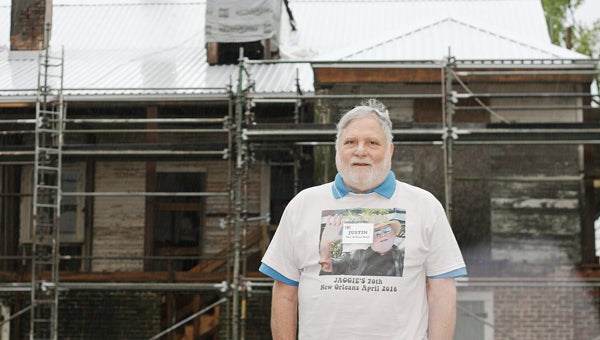Leon Godchaux’s descendents visit historic Reserve home
Published 12:09 am Wednesday, April 6, 2016

- Justin Godchaux, a fourth generation United States Godchaux family member, visited last week from Savannah, Ga., to celebrate his 70th birthday at the historic Godchaux House in Reserve. Visitors saw the progress the Godchaux-Reserve House Historical Society has done. (Raquel Derganz Baker/L’OBSERVATEUR)
RESERVE — He came all the way from Savannah, Ga., to visit the Godchaux house in Reserve.

Godchaux family and friends went in small groups to tour the inside of the Godchaux Home in Reserve Friday morning. Even though it was raining, the group of over 70 people didn’t seem to mind as they toured the home and learned more about Godchaux and what he did for Reserve.
For Justin Godchaux, gathering in the rain Friday morning with over 70 relatives and friends was a great way to celebrate his 70th birthday and share his family history with people he loved.
Dozens from all over the United States — and even some from other countries — gathered to see the Leon Godchaux home in Reserve and learn what the Godchaux-Reserve House Historical Society is doing to the building.
Many in Reserve consider Leon Godchaux the person who started the city, from purchasing land for sugar cane fields and a refinery or lending a helping hand to widows who lived in the community.
“My father was vice president of sales for the company after World War II until the company was sold,” Justin said. “I would stay down here in the summers and I have some wonderful memories. In the July 4th celebrations the whole family would participate in activities, like swimming in the swim meets.”
The Godchaux family sponsored the celebrations.
The rain Friday morning didn’t seem to damper the Godchaux family’s’ spirits as they toured the home and learned more about their family history.
“What I’m thrilled about is getting the opportunity to show some of this to my children and my grandchildren,” Justin said. “I’m trying to get them involved in our heritage. I’m the fourth (generation.) My kids are the fifth, and the grandchildren are the sixth generation of our family. I want them to have a feel of some of the history of the family.”
Michael Hoover, spokesman for the Historical Society and a history lover, spoke about how influential Leon Godchaux was to the surrounding area. Leon Godchaux was born June 10, 1894, to a Jewish family in France. Around the age of 13 he arrived at the Port of New Orleans, alone, without knowing how to read or write English or French.
“He had a dream and he had a purpose,” Hoover said. “He started his career as a door-to-door salesman. At some time he had the Leon Godchaux Clothing Company in Downtown New Orleans. Later he ended up buying land in this area. He bought it from a widow, along with the house, that was going through hard times.”
Hoover said the widow had treated Godchaux well when he would come up and down the river, so when he bought the area in Reserve, he bought her home and forgave her debt and let her live in the home until she passed.
It’s also said if there were widows in the area, Godchaux would send coal, groceries and even pay for the funeral at times.
“He created this area,” Hoover said. “He built his industry on sugar cane. He bought, I think, 12 plantations, and when he passed, it ended up being 30,000 acres. He brought his employees together as a community and as a family. He built this area, everything from baseball parks, football fields, swimming pools, a dance club and he would do fireworks during holidays.”
Hoover said the efforts were all geared to his employees.
In order to keep the legacy and history of Leon Godchaux alive, the Historical Society is renovating the Godchaux House in Reserve. Organizers plan to turn the old school house into a museum.
At some point, Hoover said, they hope to grow sections of sugar cane on the property.
“He was more than a business owner; he literally created this area,” Hoover said. “We have already completed phase one for the house, which was raising money to rebuild the location. Phase one included working on the outside; they have already done the roof and stabilized a lot of the floor area. For phase two they will be working on the inside.”
The wood used to fix the house is donated cypress that is being cut down to make way for a pipeline. Up to this point, all work on the house has been volunteer work.
By Raquel Derganz Baker





